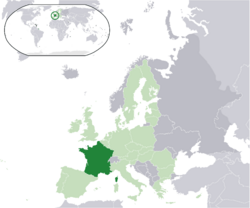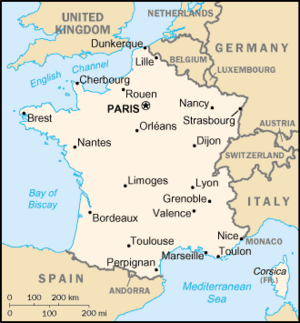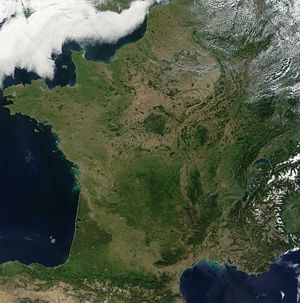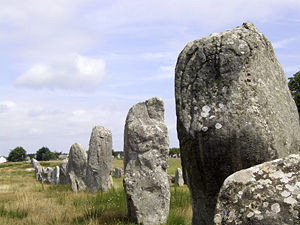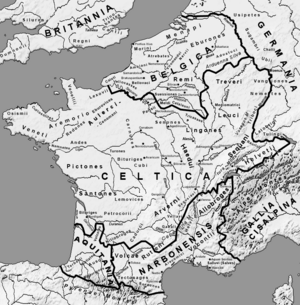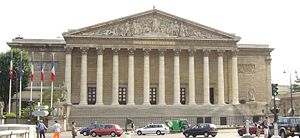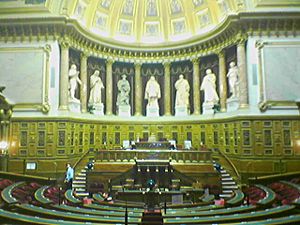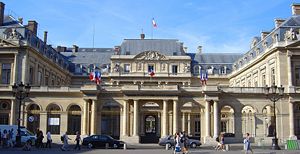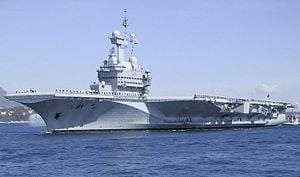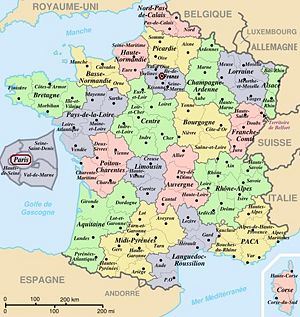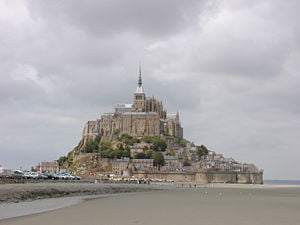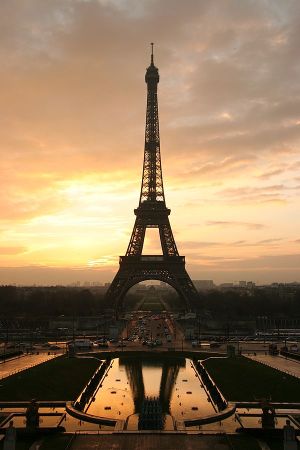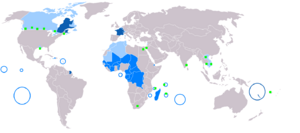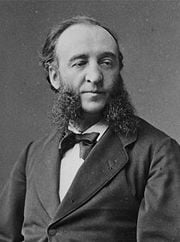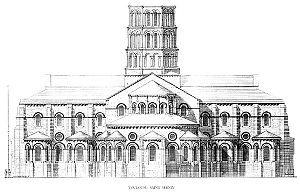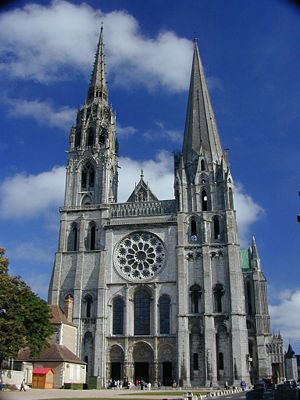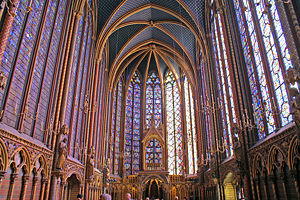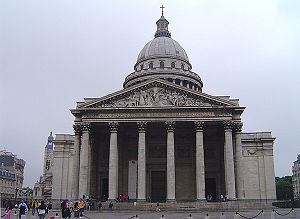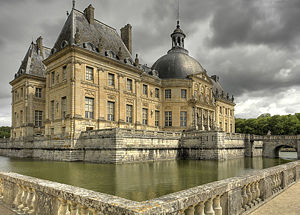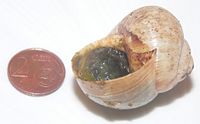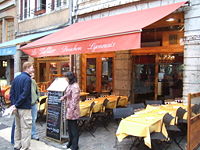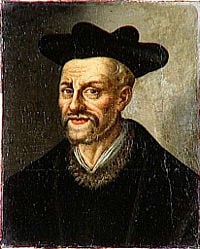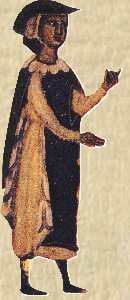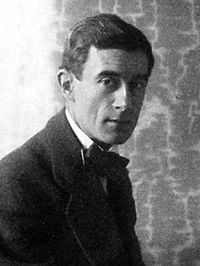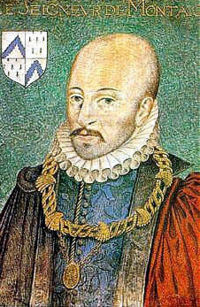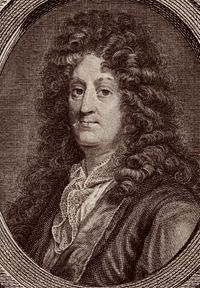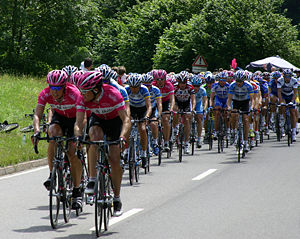Difference between revisions of "France" - New World Encyclopedia
Mike Butler (talk | contribs) |
Mike Butler (talk | contribs) |
||
| Line 281: | Line 281: | ||
===Administrative divisions=== | ===Administrative divisions=== | ||
| − | [[Image:France departements regions narrow.jpg|left|thumb|300px|The 22 regions and 96 departments of [[metropolitan France]] includes [[Corsica]] (''Corse'', lower right). Paris area is expanded (inset at left) | + | [[Image:France departements regions narrow.jpg|left|thumb|300px|The 22 regions and 96 departments of [[metropolitan France]] includes [[Corsica]] (''Corse'', lower right). Paris area is expanded (inset at left)]] |
France is divided into 26 administrative [[Regions of France|regions]]. Twenty two are in metropolitan France (21 are on the continental part of metropolitan France; one is the territorial collectivity of [[Corsica]]), and four are [[overseas region]]s. The regions are further subdivided into 100 [[Departments of France|departments]] which are numbered (mainly alphabetically). This number is used in postal codes and vehicle number plates amongst others. Four of these departments are found in the overseas regions and are simultaneously overseas regions and [[overseas department]]s and are an integral part of France (and the [[European Union]]) and thus enjoy a status similar to metropolitan departments. The 100 departments are subdivided into 341 [[Arrondissements of France|arrondissements]] which are, in turn, subdivided into 4032 [[Cantons of France|cantons]]. These cantons are then divided into 36,680 [[Communes of France|communes]], which are municipalities with an elected municipal council. There also exist 2588 [[Communes in France#Intercommunality|intercommunal]] entities grouping 33,414 of the 36,680 communes (i.e. 91.1% of all the communes). Three communes, Paris, Lyon and Marseille are also subdivided into 45 [[Municipal arrondissements of France|municipal arrondissements]]. | France is divided into 26 administrative [[Regions of France|regions]]. Twenty two are in metropolitan France (21 are on the continental part of metropolitan France; one is the territorial collectivity of [[Corsica]]), and four are [[overseas region]]s. The regions are further subdivided into 100 [[Departments of France|departments]] which are numbered (mainly alphabetically). This number is used in postal codes and vehicle number plates amongst others. Four of these departments are found in the overseas regions and are simultaneously overseas regions and [[overseas department]]s and are an integral part of France (and the [[European Union]]) and thus enjoy a status similar to metropolitan departments. The 100 departments are subdivided into 341 [[Arrondissements of France|arrondissements]] which are, in turn, subdivided into 4032 [[Cantons of France|cantons]]. These cantons are then divided into 36,680 [[Communes of France|communes]], which are municipalities with an elected municipal council. There also exist 2588 [[Communes in France#Intercommunality|intercommunal]] entities grouping 33,414 of the 36,680 communes (i.e. 91.1% of all the communes). Three communes, Paris, Lyon and Marseille are also subdivided into 45 [[Municipal arrondissements of France|municipal arrondissements]]. | ||
Revision as of 19:42, 11 November 2007
| République Française French Republic | |||||
| |||||
| Motto: Liberté, Égalité, Fraternité "Liberty, Equality, Fraternity" | |||||
| Anthem: "La Marseillaise" | |||||
|
Location of Metropolitan France (dark green)
– on the European continent (light green dark grey) – in the European Union (light green) | |||||
| Capital | Paris 48°52′N 2°19.59′E | ||||
|---|---|---|---|---|---|
| Largest city | capital | ||||
| Official languages | French | ||||
| Government | Semi-presidential unitary republic | ||||
| - President | Nicolas Sarkozy | ||||
| - Prime Minister | François Fillon | ||||
| Formation | |||||
| - French State | 843 (Treaty of Verdun) | ||||
| - Current constitution | 1958 (5th Republic) | ||||
| Accession to EU | March 25 1957 | ||||
| Area | |||||
| - Total [1] | 674843 km² (40th) 260558 sq mi | ||||
| Population | |||||
| - January 1, 2007 estimate | |||||
| - Total[1] | 64,102,140[3] | ||||
| - Metropolitan France | 61,538,322[2] | ||||
| - Density [4] | 113/km² 293/sq mi | ||||
| GDP (PPP) | 2006 estimate | ||||
| - Total | US $1.871 trillion | ||||
| - Per capita | US $30,100 | ||||
| GDP (nominal) | 2006 estimate | ||||
| - Total | US $2.232 trillion | ||||
| - Per capita | US $35,404 | ||||
| HDI (2004) | |||||
| Currency | Euro[5], CFP Franc[6] ( EUR, XPF)
| ||||
| Time zone | CET[4] (UTC+1) | ||||
| - Summer (DST) | CEST[4] (UTC+2) | ||||
| Internet TLD | .fr[7] | ||||
| Calling code | +33 | ||||
France, officially the French Republic, is a country whose metropolitan territory is located in Western Europe and that also comprises various overseas islands and territories located in other continents. Metropolitan France extends from the Mediterranean Sea to the English Channel and the North Sea, and from the Rhine to the Atlantic Ocean. French people often refer to Metropolitan France as L'Hexagone (The "Hexagon") because of the geometric shape of its territory.
In the 18th and 19th centuries, France built one of the largest colonial empires of the time, stretching across West Africa and Southeast Asia, prominently influencing the cultures and politics of the regions.
France is a developed country with the sixth-largest economy in the world.[8] France is the most visited country in the world, receiving over 79 million foreign tourists annually (including business visitors, but excluding people staying less than 24 hours in France).
France is one of the founding members of the European Union, and has the largest land area of all members. France is also a founding member of the United Nations, and a member of the Francophonie, the G8, and the Latin Union. It is one of the five permanent members of the United Nations Security Council; it is also an acknowledged nuclear power.
Origin of the name
The name "France" comes from Latin Francia, which literally means "land of the Franks" or "Frankland". One theory as to the origin of the name is that it is derived from the Proto-Germanic word frankon which translates as javelin or lance as the throwing axe of the Franks was known as a francisca. Another proposed etymology is that in an ancient Germanic language, Frank means free as opposed to slave. It is probable that the word is derived from the ethnic name of the Franks, the connection being that only the Franks, as the conquering class, had the status of freemen. In German, France is still called Frankreich, which literally means "Realm of the Franks". In order to distinguish from the Frankish Empire of Charlemagne, Modern France is called Frankreich, while the Frankish Realm is called Frankenreich.
Geography
France is bordered by Belgium, Luxembourg, Germany, Switzerland, Italy, Monaco, Andorra, and Spain. France is also linked to the United Kingdom by the Channel Tunnel, which passes underneath the English Channel. Corsica lies off the Mediterranean coast. Due to its overseas departments, France also shares land borders with Brazil and Suriname (bordering French Guiana), and the Netherlands Antilles (bordering Saint-Martin).
While Metropolitan France is located in Western Europe, France also has a number of territories in North America, the Caribbean, South America, the southern Indian Ocean, the Pacific Ocean, and Antarctica. These territories have varying forms of government ranging from overseas department to overseas collectivity.
Metropolitan France covers 213,010 square miles (551,695 square kilometers) making it the largest country in area in the European Union, being only slightly larger than Spain, or slightly less than the size of Texas, in the United States.
France possesses a wide variety of landscapes, from coastal plains in the north and west to mountain ranges of the Alps in the south-east, the Massif Central in the south-central and Pyrenees in the south-west. At 15,770 feet (4807 meters) above sea-level, the highest point in Western Europe, Mont Blanc, is situated in the Alps on the border between France and Italy.
Metropolitan France lies within the northern temperate zone. The north and northwest have a temperate climate, however, a combination of maritime influences, latitude and altitude produce a varied climate in the rest of Metropolitan France. In the south-east a Mediterranean climate prevails. In the west, the climate is predominantly oceanic with a high level of rainfall, mild winters and cool summers. Inland the climate becomes more continental with hot, stormy summers, colder winters and less rain. The climate of the Alps and other mountainous regions are mainly alpine in nature with the number of days with temperatures below freezing over 150 per year and snowcover lasting for up to six months.
France also has extensive river systems such as the Loire, the Garonne, the Seine and the Rhône, which divides the Massif Central from the Alps and flows into the Mediterranean sea at the Camargue, the lowest point in France (2 m / 6.5 ft below sea level).
A major divide, running from the southern end of the Vosges down the eastern and southeastern edge of the Massif Central to the Noire Mountains, is the source of most of the rivers of the larger, western part of the country, including the Seine and the Loire. Other main rivers are the Garonne, flowing from the Pyrenees, and the Rhône and the Rhine, originating in the Alps.
France has forests of has chestnut and beech in the Massif Central, juniper and dwarf pine in the subalpine zone, with pine forests and various oaks in the south. Eucalyptus from Australia and dwarf pines abound in Provence, while olive trees, vines, mulberry, fig trees, as well as laurel, wild herbs, and maquis scrub grow in the Mediterranean area.
Brown bear, chamois, marmot, and alpine hare live in the Pyrenees and the Alps. Polecats, marten, wild boar, and various deer live in the forests. Hedgehog, shrew, fox, weasel, bat, squirrel, badger, rabbit, mouse, otter, and beaver are common. Birds include warblers, thrushes, magpies, owls, buzzards, and gulls. There are storks in Alsace, eagles and falcons in the mountains, pheasants and partridge in the south. Flamingos, terns, buntings, herons, and egrets are found in the Mediterranean zone. The rivers contain eels, pike, perch, carp, roach, salmon, and trout, while lobster and crayfish are found in the Mediterranean.
France's natural resources includes coal, iron ore, bauxite, fish, timber, potash, and zinc.
Natural hazards include flooding, avalanches, and forest fires. Environmental issues include forest damage from acid rain, air pollution from industrial and vehicle emissions, water pollution from urban wastes, and agricultural run-off.
Paris, the capital city, is situated on the River Seine, in northern France, at the heart of the Île-de-France region. The City of Paris has an estimated population of 2,153,600 within its administrative limits. The Paris unité urbaine (similar to the North American "urban area") is an area of unbroken urban growth that extends well beyond the administrative city limits and has a population of 9.93 million. An important settlement for more than two millennia, Paris is today one of the world's leading business and cultural centres, and its influence in politics, education, entertainment, media, fashion, science and the arts all contribute to its status as one of the world's major global cities.
History
Pre-history
The Neanderthals, the earliest Homo sapiens to occupy Europe, are thought to have arrived there around 300,000 B.C.E., but seem to have died out by about by 30,000 B.C.E., presumably unable to compete with modern humans during a period of cold weather. The earliest modern humans — Cro-Magnons — entered Europe (including France) around 40,000 years ago during a long interglacial period of particularly mild climate, when Europe was relatively warm, and food was plentiful. When they arrived in Europe, they brought with them sculpture, engraving, painting, body ornamentation, music and the painstaking decoration of utilitarian objects. Some of the oldest works of art in the world, such as the cave paintings at Lascaux in southern France, are datable to shortly after this migration.
During the Neolithic period (ca. 4500 B.C.E.–1700B.C.E.), which is characterised by the adoption of agriculture, the development of pottery and more complex, larger settlements, there was an expansion of peoples from southwest Asia into Europe. From the Neolithic to the Bronze Age (2000-800 B.C.E.), Indo-European and Proto-Celtic peoples spread across Western Europe. By 800 B.C.E., the Hallstatt people, who were warriors and shepherds from the Alpine region, introduced the techniques of working with iron. In the 5th century .bc.e., the La Tène culture gradually transformed into the explicitly Celtic culture of early historical times.
Gaul
Covering large parts of modern day France, Belgium, and northwest Germany, Gaul was inhabited by many Celtic tribes whom the Romans referred to as Gauls and who spoke the Gaulish language. On the lower Garonne the people spoke an archaic language related to Basque, the Aquitanian language. The Celts founded cities such as Lutetia Parisiorum (Paris) and Burdigala (Bordeaux) while the Aquitanians founded Tolosa (Toulouse).
Long before any Roman settlements, Greek navigators settled in what would become Provence. The Phoceans founded important cities such as Massalia (Marseilles) and Nicaea (Nice), bringing them in to conflict with the neighboring Celts and Ligurians. The Celts themselves often fought with Aquitanians and Germans, and a Gaulish war band led by Brennus invaded Rome circa 390 or 387 B.C.E. following the Battle of the Allia. When Hannibal Barca fought the Romans, he recruited several Gaulish mercenaries which fought on his side at Cannae. It was this Gaulish participation that caused Provence to be annexed in 121 B.C.E. by the Roman Republic. Despite Gaulish opposition led by Vercingetorix, the Overking of the Warriors, Gauls succumbed to the Roman onslaught; the Gauls had some success at first at Gergovia, but were ultimately defeated at Alesia.
Roman Gaul
Roman Gaul consisted of an area of provincial rule in the Roman Empire, in modern day France, Belgium, Luxembourg, and western Germany. Roman control of the area lasted for 600 years. The Roman Empire began its takeover of what was Celtic Gaul in 121 B.C.E., when it conquered and annexed the southern reaches of the area. Julius Caesar completed the task by defeating the Celtic tribes in the Gallic Wars of 58-51 B.C.E. Gaul was divided into several different provinces. The Romans displaced populations in order to prevent local identities to become a threat to the Roman control. The Romans founded cities such as Lugdunum (Lyon) and Narbonensis (Narbonne). The Gauls eventually adopted Roman speech (Latin, from which the French language evolved) and Roman culture. The Roman administration finally collapsed as remaining troops were withdrawn southeast to protect Italy. Between 455 and 475, the Visigoths, the Burgundians, and the Franks assumed power in Gaul.
Merovingians
Following the Frankish defeat of the Romans at the Battle of Soissons in AD 486, Gaul came under the rule of the Merovingians, the first kings of France., and
Christianity took root in the 2nd century and 3rd century AD, and became so firmly established by the fourth and fifth centuries that St. Jerome wrote that Gaul was the only region "free from heresy".
In the 4th century AD, Gaul's eastern frontier along the Rhine was overrun by Germanic tribes, principally the Franks, from whom the ancient name of "Francie" was derived. The modern name "France" derives from the name of the feudal domain of the Capetian Kings of France around Paris.
The Franks were the first tribe among the Germanic conquerors of Europe after the fall of the Roman Empire to convert to Catholic Christianity rather than Arianism (their King Clovis did so in 498); thus France obtained the title "Eldest daughter of the Church" (La fille ainée de l'Église), and the French would adopt this as justification for calling themselves "the Most Christian Kingdom of France".
Carolingians
Existence as a separate entity began with the Treaty of Verdun (843), with the division of Charlemagne's Carolingian empire into East Francia, Middle Francia and Western Francia. Western Francia approximated the area occupied by modern France and was the precursor to modern France.
The Vikings and Normandy
Early Capetians
The Carolingians ruled France until 987, when Hugh Capet, Duke of France and Count of Paris, was crowned King of France. His descendants, the Direct Capetians, the House of Valois and the House of Bourbon, progressively unified the country through a series of wars and dynastic inheritance.
Later Capetians
Hundred Years' War
Black Death
Joan of Arc
The Renaissance
The Reformation
Wars of Religion
Louis XIII and Cardinal Richelieu
Louis XIV
The French Revolution
Napoleon and the Empire
Constitutional monarchy
Second Empire and Second Republic
The Third Republic
The Dreyfus Affair
World War I
Internal affairs between the wars
World War II
Colonial and defence policy
de Gaulle
The monarchy reached its height during the 17th century and the reign of Louis XIV. At this time France possessed the largest population in Europe (see Demographics of France) and had tremendous influence over European politics, economy, and culture. France obtained many overseas possessions in the Americas, Africa and Asia.
Monarchy to republic
The monarchy ruled France until the French Revolution, in 1789. King Louis XVI and his wife, Marie Antoinette, were executed, along with thousands of other French citizens. After a series of short-lived governmental schemes, Napoleon Bonaparte seized control of the Republic in 1799, making himself First Consul, and later Emperor of what is now known as the First French Empire (1804–1814). In the course of several wars, his armies conquered most of continental Europe, with members of the Bonaparte family being appointed as monarchs of newly established kingdoms.
Following Napoleon's final defeat in 1815 at the Battle of Waterloo, the French monarchy was re-established, but with new constitutional limitations. In 1830, a civil uprising established the constitutional July Monarchy, which lasted until 1848. The short-lived Second Republic ended in 1852 when Louis-Napoléon Bonaparte proclaimed the Second French Empire. Louis-Napoléon was unseated following defeat in the Franco-Prussian war of 1870 and his regime was replaced by the Third Republic.
France had colonial possessions, in various forms, since the beginning of the 17th century until the 1960s. In the 19th and 20th centuries, its global colonial empire was the second largest in the world behind the British Empire. At its peak, between 1919 and 1939, the second French colonial empire extended over 12,347,000 square kilometres (4,767,000 sq mi) of land. Including metropolitan France, the total area of land under French sovereignty reached 12,898,000 square kilometres (4,980,000 sq mi) in the 1920s and 1930s, which is 8.6% of the world's land area.

Though ultimately a victor in World War I, France suffered enormous human and material losses that weakened it for decades to come. The 1930s were marked by a variety of social reforms introduced by the Popular Front government. At the start of World War II, France held a series of unsuccessful rescue campaigns in Norway, Belgium and The Netherlands from 1939 to 1940. Upon the May-June 1940 Nazi German blitzkrieg and its Fascist Italian support, France's political leadership disregarded Churchill's proposal of a Franco-British Union and signed the Second Armistice at Compiègne surrender on June 22 1940. The Germans established a puppet regime under Marshal Philippe Pétain known as Vichy France, which pursued a policy of collaboration with Nazi Germany. The regime's opponents formed the Free French Forces outside of France and the French Resistance inside. France was liberated with the joint effort of the United States, the United Kingdom, Canada, the Free French Forces and the French resistance in 1944. Soon the Nouvelle Armée Française ("new French army") was established with the massive help of US-built material and equipment, and pursued the fight along the Allies in various battles including the campaign of Italy.
The French Fourth Republic was established after World War II and struggled to maintain its economic and political status as a dominant nation state. France attempted to hold on to its colonial empire, but soon ran into trouble. The half-hearted 1946 attempt at regaining control of French Indochina resulted in the First Indochina War, which ended in French defeat at the Battle of Dien Bien Phu in 1954. Only months later, France faced a new, even harsher conflict in its oldest major colony, Algeria.
The debate over whether or not to keep control of Algeria, then home to over one million European settlers, wracked the country and nearly led to civil war. In 1958, the weak and unstable Fourth Republic gave way to the Fifth Republic, which contained a strengthened Presidency. In the latter role, Charles de Gaulle managed to keep the country together while taking steps to end the war. The Algerian War and Franco-French civil war that resulted in the capital Algiers, was concluded with peace negotiations in 1962 that led to Algerian independence.
In recent decades, France's reconciliation and cooperation with Germany have proved central to the political and economic integration of the evolving European Union, including the introduction of the euro in January 1999. France has been at the forefront of the European Union member states seeking to exploit the momentum of monetary union to create a more unified and capable European Union political, defence, and security apparatus. However, the French electorate voted against ratification of the European Constitutional Treaty in May 2005.
Government and politics

Constitutional structure
The French Republic is a unitary semi-presidential republic with strong democratic traditions. The constitution of the Fifth Republic was approved by referendum on September 28, 1958. It greatly strengthened the authority of the executive in relation to parliament.
The president is the chief of state and is elected by popular vote for a five-year term (formerly seven years). An election was held in April and May of 2007. The prime minister is nominated by a national assembly majority and appointed by the president. A council of ministers appointed by the president at the suggestion of the prime minister.
The French parliament is a bicameral legislature comprising a national assembly (Assemblée Nationale) and a senate. The 577 national assembly deputies (555 for metropolitan France, 15 for overseas departments, and seven for dependencies) are elected by popular vote under a single-member majority system to serve five-year terms. The assembly has the power to dismiss the cabinet, and thus the majority in the Assembly determines the choice of government.
The 331 senators (305 for metropolitan France, nine for overseas departments, five for dependencies, and 12 for French nationals abroad) are indirectly elected by an electoral college to serve nine-year terms, with one third elected every three years. The Senate's legislative powers are limited; in the event of disagreement between the two chambers, the National Assembly has the final say, except for constitutional laws and lois organiques (laws that are directly provided for by the constitution) in some cases. The government has a strong influence in shaping the agenda of Parliament.
Suffrage is universal for those aged 18 and over. French politics are characterised by two politically opposed groupings: one left-wing, centred around the French Socialist Party, and the other right-wing, centred previously around the Rally for the Republic(RPR)]] and now its successor the Union for a Popular Movement. The executive branch was composed mostly of the UPM in 2007.
The judiciary consists of Supreme Court of Appeals (Cour de Cassation), the judges of which are appointed by the president from nominations of the High Council of the Judiciary, a Constitutional Council with three members appointed by the president, three appointed by the president of the National Assembly, and three appointed by the president of the Senate, and the Council of State.
Law
France uses a civil legal system; that is, law arises primarily from written statutes; judges are not to make law, but merely to interpret it (though the amount of judge interpretation in certain areas makes it equivalent to case law). Basic principles of the rule of law were laid in the Napoleonic Code. In agreement with the principles of the Declaration of the Rights of Man and of the Citizen law should only prohibit actions detrimental to society.
French law is divided into two principal areas: private law and public law. Private law includes, in particular, civil law and criminal law. Public law includes, in particular, administrative law and constitutional law. However, in practical terms, French law comprises three principal areas of law: civil law; criminal law and administrative law.
France does not recognise religious law, nor does it recognise religious beliefs or morality as a motivation for the enactment of prohibitions. As a consequence, France has long had neither blasphemy laws nor sodomy laws (the latter being abolished in 1791). However "offences against public decency" (contraires aux bonnes mœurs) or breach of the peace (trouble à l'ordre public) have been used to repress public expressions of homosexuality or street prostitution.
Laws can only address the future and not the past (ex post facto laws are prohibited); and to be applicable, laws must be officially published in the Journal Officiel de la République Française.
Foreign relations
- See also: European Union , Latin Union , Francophonie , and United Nations Security Council
France is a member of the United Nations and serves as one of the permanent members of the U.N. Security Council with veto rights. It is also a member of the WTO, the Secretariat of the Pacific Community (SPC), the Indian Ocean Commission (COI). It is an associate member of the Association of Caribbean States (ACS) and a leading member of the International Francophone Organisation (OIF) of 51 fully or partly French-speaking countries. It hosts the headquarters of the OECD, UNESCO, Interpol, Alliance Base and the International Bureau for Weights and Measures. In 1953 France received a request from the United Nations to pick a coat of arms that would represent it internationally. Thus the French emblem was adopted and is currently used on passports.
French foreign policy has been largely shaped by membership of the European Union, of which it was a founding member. In the 1960s, France sought to exclude the British from the organization, seeking to build its own standing in continental Europe. Since the 1990s, France has developed close ties with reunified Germany to become the most influential driving force of the EU, but consequently rivaling the U.K. and limiting the influence of newly-inducted East European nations. France is a member of the North Atlantic Treaty Organization, but under President de Gaulle, it excluded itself from the joint military command to avoid the supposed domination of its foreign and security policies by U.S. political and military influence. In the early 1990s, the country drew considerable criticism from other nations for its atmospheric nuclear tests in Polynesia. France vigorously opposed the 2003 invasion of Iraq, straining bilateral relations with the U.S. and the U.K. France retains strong political and economic influence in its former African colonies and has supplied economic aid and troops for peace-keeping missions in the Ivory Coast and Chad.
Military
The French armed forces comprises an army, navy, air force, and French Gendarmerie, a military force which acts as a National Rural Police and as a Military police for the entire French military.
Since the Algerian War, conscription was steadily reduced and was finally suspended in 2001 by Jacques Chirac. The total number of military personnel is approximately 359,000. France spends 2.6 percent of its GDP on defence, slightly more than the United Kingdom (2.4 percent), and is the highest in the European Union where defence spending is generally less than 1.5 percent of GDP. Together they account for 40% of EU defence spending. About 10% of France's defence budget goes towards its nuclear weapons. A significant part of French military equipment is made in France. Examples include the Rafale fighter, the Charles de Gaulle aircraft carrier, the Exocet missile, and the Leclerc tank.
Some weaponry, like the E-2 Hawkeye or the E-3 Sentry was bought from the United States. Despite withdrawing from the Eurofighter project, France is actively investing in European joint projects such as the Eurocopter Tiger, multipurpose frigates, the UCAV demonstrator nEUROn and the Airbus A400M. France is a major arms seller as most of its arsenal's designs are available for the export market with the notable exception of nuclear powered devices.
The French nuclear force consisted, in 2007, of four submarines equipped with M45 ballistic missiles. The French dissuasion force uses the Mirage 2000N; it is a variant of the Mirage 2000 and thus is designed to deliver nuclear strikes. Other nuclear devices like the Plateau d'Albion's Intercontinental ballistic missiles and the short range Hadès missiles have been disarmed. With 350 nuclear heads stockpiled France is the world's third largest nuclear power.
The Marine Nationale is regarded as one of the world's most powerful navies. The professional compendium flottes de combats, in its 2006 edition, ranked it world's sixth biggest navy after the American, Russian, Chinese, British and Japanese navies.
The Armée de Terre employs 133,500 people, it is very famous for the Légion Etrangère though the French special forces aren't the Legion but the Dragons Parachutistes and the Marines Parachutistes. The French assault rifle is the FAMAS and future infantry combat system is the Félin.
The Armée de l'Air is the oldest and first professional air force worldwide. It still today retains a significant capacity. It uses mainly two aircraft fighters: the older Mirage F1 and the more recent Mirage 2000. The later model exists in a ground attack version called the Mirage2000D. The highly modern Rafale is in deployment in both the French air force and navy.
Administrative divisions
France is divided into 26 administrative regions. Twenty two are in metropolitan France (21 are on the continental part of metropolitan France; one is the territorial collectivity of Corsica), and four are overseas regions. The regions are further subdivided into 100 departments which are numbered (mainly alphabetically). This number is used in postal codes and vehicle number plates amongst others. Four of these departments are found in the overseas regions and are simultaneously overseas regions and overseas departments and are an integral part of France (and the European Union) and thus enjoy a status similar to metropolitan departments. The 100 departments are subdivided into 341 arrondissements which are, in turn, subdivided into 4032 cantons. These cantons are then divided into 36,680 communes, which are municipalities with an elected municipal council. There also exist 2588 intercommunal entities grouping 33,414 of the 36,680 communes (i.e. 91.1% of all the communes). Three communes, Paris, Lyon and Marseille are also subdivided into 45 municipal arrondissements.
The regions, departments and communes are all known as territorial collectivities, meaning they possess local assemblies as well as an executive. Arrondissements and cantons are merely administrative divisions. However, this was not always the case. Until 1940, the arrondissements were also territorial collectivities with an elected assembly, but these were suspended by the Vichy regime and definitely abolished by the Fourth Republic in 1946. Historically, the cantons were also territorial collectivities with their elected assemblies.
The French Republic also has six overseas collectivities, one sui generis collectivity (New Caledonia), and one overseas territory. Overseas collectivities and territories form part of the French Republic, but do not form part of the European Union or its fiscal area. The Pacific territories continue to use the Pacific franc whose value is linked to that of the euro. In contrast, the four overseas regions used the French franc and now use the euro.
France also maintains control over a number of small non-permanently inhabited islands in the Indian Ocean and the Pacific Ocean: Bassas da India, Clipperton Island, Europa Island, Glorioso Islands, Juan de Nova Island, Tromelin Island.
Overseas departments have the same political status as metropolitan departments. They includeGuadeloupe, Martinique, French Guiana, and Réunion, all since 1946.
Marianne
Marianne is a symbol of the French Republic. She is an allegorical figure of liberty and the Republic and first appeared at the time of the French Revolution. The earliest representations of Marianne are of a woman wearing a Phrygian cap. The origins of the name Marianne are unknown, but Marie-Anne was a very common first name in the eighteenth century. Anti-revolutionaries of the time derisively called her La Gueuse (the Commoner). It is believed that revolutionaries from the South of France adopted the Phrygian cap as it symbolised liberty, having been worn by freed slaves in both Greece and Rome. Mediterranean seamen and convicts manning the galleys also wore a similar type of cap.
Economy
Following the Second World War, France embarked on an ambitious programme of modernisation. This programme of dirigisme, mostly implemented by socialist governments, involved the state control of industry, such as transportation, energy and telecommunication infrastructures. However, dirigisme came to be highly contested after 1981 when newly elected socialist president François Mitterrand called for increased governmental control in the economy, nationalising many industries and private banks. By 1983, with the initial bad economic results the government decided to renounce dirigisme and start the era of rigueur ("rigour") or corporatisation.
France, in 2007, was in the midst of transition from a well-to-do modern economy that has featured extensive government ownership and intervention to one that relies more on market mechanisms. The government has partially or fully privatized many large companies, banks, and insurers, and has ceded stakes in such leading firms as Air France, France Telecom, Renault, and Thales. It maintains a strong presence in some sectors, particularly power, public transport, and defense industries. The telecommunications sector is gradually being opened to competition.
France's leaders remained committed to a capitalism in which tax policies, and social spending reduce income disparity. The government in 2006 focused on introducing measures that attempt to boost employment through increased labor market flexibility; however, the population has remained opposed to labor reforms, hampering the government's ability to revitalize the economy.
The tax burden remained one of the highest in Europe (nearly 50 percent of GDP in 2005). The lingering economic slowdown and inflexible budget items probably pushed the budget deficit above the eurozone's three percent-of-GDP limit in 2006; unemployment hovers near nine percent. With at least 75 million foreign tourists per year, France is the most visited country in the world and maintains the third largest income in the world from tourism.
Legislation passed in 1998 shortened the legal workweek from 39 to 35 hours. A key objective was to encourage job creation, for which significant new subsidies were to be made available.
Membership in France's labour unions accounts for less than 10 percent of the private sector workforce and is concentrated in the education, manufacturing, transportation, and heavy industry sectors. Most unions are affiliated with one of the competing national federations, the largest and most powerful of which are the CGT, FO, and CFDT. French unions are fairly weak, and strikes are uncommon in most of the economy. Nonetheless, unions are powerful in some parts of the public sector, particularly public transportation (SNCF national railways, RATP Paris transit authority and air traffic control), where strikes have an instant effect on the general public and attract the attention of the national and foreign press.
A member of the G8 group of leading industrialised countries, it is ranked as the sixth largest economy in the world in 2005, behind the United States, Japan, Germany, The People's Republic of China and the United Kingdom. France joined 11 other EU members to launch the Euro on January 1, 1999, with euro coins and banknotes replacing the French franc (₣) in early 2002.
In the 2005 edition of OECD in Figures, the OECD noted that France led the G7 countries in terms of productivity (measured as GDP per hour worked). In 2004, the GDP per hour worked in France was $47.7, ranking France above the United States ($46.3), Germany ($42.1), the United Kingdom ($39.6), or Japan ($32.5).
But France's GDP per capita is significantly lower than the US GDP per capita, being in fact comparable to the GDP per capita of the other European countries, which is on average 30 percent below the US level. The reason for this is that a much smaller percentage of the French population is working compared to the US, which lowers the GDP per capita of France, despite its higher productivity. In fact, France has one of the lowest percentages of its population aged 15-64 years at work among the OECD countries. In 2004, 68.8 percent of the French population aged 15-64 years was in employment, compared to 80 percent in Japan, 78.9 percent in the UK, 77.2 percent in the US, and 71 percent in Germany.
This phenomenon is the result of almost 30 years of massive unemployment in France, which has led to three consequences reducing the size of the working population: about 9 percent of the active population is without a job; students delay as long as possible their entry into labour market; and finally, the French government gives various incentives to workers to retire in their early 50s, though these are now receding.
France has an important aerospace industry led by the European consortium Airbus, and is the only European power (excluding Russia) to have its own national spaceport (Centre Spatial Guyanais). France is also the most energy independent Western country due to heavy investment in nuclear power, which also makes France the smallest producer of carbon dioxide among the seven most industrialised countries in the world. As a result of large investments in nuclear technology, most of the electricity produced in the country is generated by nuclear power plants (78.1 percent in 2006, up from only eight percent in 1973.
Large tracts of fertile land, the application of modern technology, and EU subsidies have combined to make France the leading agricultural producer and exporter in Europe. Wheat, poultry, dairy, beef, and pork, as well as an internationally recognised foodstuff and wine industry are primary French agricultural exports. EU agriculture subsidies to France total almost $14 billion.
The railway network in France totals 31,840 kilometres (19,784 mi), the most extensive in Western Europe, and is operated by the SNCF. High speed trains include the Thalys, the Eurostar and the TGV, which travels at 200 mph (320 km/h) in commercial use. The Eurostar, along with the Eurotunnel Shuttle, connects with the United Kingdom through the Channel Tunnel.
There is approximately 555,070 miles (893,300km) of serviceable roadway in France. There is no annual registration fee or road tax; however, motorway usage is through tolls except in the vicinity of large communes. The new car market is dominated by national brands such as Renault (27 percent of cars sold in France in 2003), Peugeot (20.1 percent) and Citroën (13.5 percent). Over 70 percent of new cars sold in 2004 had diesel engines.
There are approximately 478 airports in France, including landing fields. The most important and largest of these is Charles de Gaulle International Airport just outside Paris; it is also the main hub of Air France, the French national airline. There are 10 major ports in France, the largest of which is in Marseille, which also is the largest bordering the Mediterranean Sea.
Exports totalled $483.1-billion in 2006. Export commodities included machinery and transportation equipment, aircraft, plastics, chemicals, pharmaceutical products, iron and steel, and beverages. Export partners included Germany 15.6 percent, Spain 9.6 percent, Italy 8.9 percent, the UK 8.2 percent, Belgium 7.2 percent, the US 6.7 percent, Netherlands 4 percent.
Imports totalled $520.8-billion in 2006. Import commodities included machinery and equipment, vehicles, crude oil, aircraft, plastics, and chemicals. Import partners included Germany 19 percent, Belgium 11 percent, Italy 8.3 percent, Spain 7 percent, Netherlands 6.7 percent, UK 6.5 percent, US 4.6 percent.
The GDP per_capita was $35,404 in 2006, a rank of 18 out of 194 countries. The unemployment rate was 8.7 percent in 2006, and 6.2 percent of the population existed below the poverty line in 2004.
Demography
Population
France's population was 61,538,322 in January 2007, counting only its metropolitan territory; if overseas departments and territories are included, France's population would be 64,102,140. Life expectancy at birth for the total population was 80.59 years in 2007.
At the beginning of the twentieth century, France's rate of population growth was low compared to its neighbours, and to its past history. However, the country's population sharply increased with the baby boom following World War II. During the Trente Glorieuses (1945-1974), the country's reconstruction and steady economic growth led to the labor-immigration of the 1960s, when many employers went looking for manpower in villages located in Southern Europe and in the Maghreb (or North Africa). French law made it easy for thousands of colons, ethnic or national French from former colonies of North and East Africa, India and Indochina to live in mainland France. 1.6 million European pieds noirs migrated from Algeria, Tunisia and Morocco. In the 1970s, over 30,000 French colons left Cambodia during the Khmer Rouge regime as the Pol Pot government confiscated their farms and land properties. However, after the 1973 energy crisis, laws limiting immigration were passed. In addition, the country's birth rate dropped significantly during this time.
Since the 1980s, France has ceased being a country of mass immigration. Meanwhile, the national birth rate, after continuing to drop for a time, began to rebound in the 1990s and currently the country's fertility rate is close to the replacement level. In recent years, immigrants have accounted for one quarter of the population growth - a lower proportion than in most other European countries - according to an INSEE 2006 study.
A perennial political issue concerns rural depopulation. Over the period 1960-1999 fifteen rural départements experienced a decline in population. In the most extreme case, the population of Creuse fell by 24 percent.
Ethnicity
Since the beginning of the Third Republic (1871-1940), the state has not categorized people according to their alleged ethnic origins. Hence, in contrast to the US census, French people are not asked to define their ethnic appartenance, whichever it may be. The usage of ethnic and racial categorization is avoided to prevent any case of discrimination, same regulations apply to religious membership data cannot be compiled under the French Census. This classic French republican non-essentialist conception of nationality is officialized by the French Constitution, according to whom "French" is a nationality, and not a specific ethnicity. France is an ethnically diverse nation, including people of Celtic, Latin, Teutonic, Slavic, North African, Indochinese ancestry, as well as Basque minorities. Conflict between the government and regional groups including Corsicans, Bretons, and Basques escalated toward the end of the twentieth century, with a heightened push for political autonomy.
Religion
France is a secular country where freedom of thought and of religion are preserved, in virtue of the 1789 Declaration of the Rights of Man and of the Citizen. The Republic is based on the principle of laïcité, that is of freedom of religion (including agnosticism and atheism) enforced by the 1880s Jules Ferry laws and the 1905 French law on the separation of church and state. Roman Catholicism, the religion of up to 88 percent of the French people, is no longer considered a state religion, as it was before the 1789 Revolution and throughout the various, non-republican regimes of the nineteenth century (the Restauration, the July Monarchy and the Second Empire).
According to a January 2007 poll by the Catholic World News: 51 percent identified as being Catholics, 31 percent identified as being agnostics or atheists. (Another poll concluded that 27 percent identified as being atheists.), 10 percent identified as being from other religions or being without opinion, 4 percent identified as Muslim, 3 percent identified as Protestant, 1 percent identified as Jewish.
According to the most recent Eurobarometer Poll 2005, 34 percent of French citizens responded that "they believe there is a god", whereas 27 percent answered that "they believe there is some sort of spirit or life force" and 33 percent that "they do not believe there is any sort of spirit, god, or life force".
The current Jewish community in France numbers around 600,000 according to the World Jewish Congress and is largest in Europe. Estimates of the number of Muslims in France vary widely. According to the 1999 French census returns, there were only 3.7 million people of "possible Muslim faith" in France (6.3 percent of the total population). There are an estimated 200,000 to 1 million illegal immigrants in France.
The concept of laïcité means the French government is legally prohibited from recognising any religion (except for legacy statutes like those of military chaplains and Alsace-Moselle). Instead, it merely recognises religious organisations, according to formal legal criteria that do not address religious doctrine. Conversely, religious organisations should refrain from intervening in policy-making. Tensions occasionally erupt about alleged discrimination against minorities, especially against Muslims (see Islam in France).
Language
French (français) is a Romance language originally spoken in France, Belgium, Luxembourg, and Switzerland, and today by about 300 million people around the world as either a native or a second language, with significant populations in 54 countries. French is a descendant of the Latin of the Roman Empire, as are languages such as Spanish, Italian, Catalan, Romanian, and Portuguese. Its development was also influenced by the native Celtic languages of Roman Gaul and by the Germanic language of the post-Roman Frankish invaders. It is an official language in 29 countries, most of which form what is called in French La Francophonie, the community of French-speaking nations. It is an official language of all United Nations agencies and a large number of international organisations.
According to Article 2 of the Constitution, French is the sole official language of France since 1992. This makes France the only Western European nation (excluding microstates) to have only one officially recognised language. However, 77 regional languages are also spoken, in metropolitan France as well as in the overseas departments and territories. These include Breton, Catalan, Corsican, Basque, Alsatian, and Flemish. Until recently, the French government and state school system discouraged the use of any of these languages, but they are now taught to varying degrees at some schools. Other languages, such as Portuguese, Italian, Maghrebi Arabic and several Berber languages are spoken by immigrants.
The nation has two linguistic regions: that of the langue d'oeil to the north and that of the langue d'oc to the south.
L'Académie française, or the French Academy, is the pre-eminent French learned body on matters pertaining to the French language. The Académie was officially established in 1635 by Cardinal Richelieu, the chief minister to King Louis XIII. Suppressed in 1793 during the French Revolution, it was restored in 1803 by Napoleon Bonaparte (the Académie considers itself having been suspended, not suppressed, during the revolution). It is the oldest of the five académies of the Institut de France. The Académie consists of 40 members, known as immortels (immortals). New members are elected by the members of the Académie itself. Académicians hold office for life, but they may be removed for misconduct. The body has the task of acting as an official authority on the language; it is charged with publishing an official dictionary of the language. Its rulings, however, are only advisory; not binding on either the public or the government.
Men and women
In peasant households, women carried out the domestic tasks of housekeeping, food preparation, and child care. With industrialization, worked outside the home as washerwomen, factory workers, and domestics. By the end of the twentieth century, almost half of all workers were female and the dual-career family was normal. However, women continued to face lower wages than men for comparable work and more difficult career paths. Women did not gain the right to vote until 1944, and it was only in the 1960s that wives gain the right to open bank accounts or work without the husband's permission.
Marriage and the family
The marriage rate is declining, the average age of marriage for men is 29, and that for women is 27. Most marriages involve partners from the same department, and mostly from the same religion. One in three marriages ends in divorce. All marriages have a civil ceremony in the town hall, and many are followed by a religious ceremony. Payment for the weddings is divided equally between both families. Cohabitation of unmarried couples has increased. A law, passed in 1999, set up an intermediate union between marriage and cohabitation, including homosexual couples, which is easier to dissolve than a marriage.
The basic domestic unit is called le ménage, which includes all persons living in the same dwelling, and who are not necessarily related. In 1997, most households consisted of couples with (35 percent) or without (28 percent) children. Single women made up 18 percent of all households, and 12 percent of single men. The nuclear family was most prevalent in southern France, and is where a young couple is established in their own household by both sets of parents. The patriarchal family prevaled in rural areas of central France), where siblings stayed at home, with their spouses, and owned property jointly, as did the stem family, where the eldest son would remain in the family home, while other siblings had to seek their fortunes elsewhere. That pattern persists in some country areas, although primogeniture has been illegal since 1804. The family continues to play a key role in transmitting cultural values.
Education
The French educational system is highly centralised, and is divided into three different stages: primary, secondary, and higher education. Primary and secondary education is predominantly public (private schools also exist, in particular a strong nationwide network of primary and secondary Catholic education), while higher education has both public and private elements.
While the French trace the development of their educational system to Charlemagne, the modern era of French education begins at the end of the nineteenth century. Jules Ferry, a lawyer holding the office of Minister of Public Instruction in the 1880s, is widely credited for creating the modern Republican school by requiring all children under the age of 15 — boys and girls — to attend. He also made public instruction free of charge and secular.
The teachers in public primary and secondary schools are all state civil servants, making the ministère the largest employer in the country. Professors and researchers in France's universities are also employed by the state. At the primary and secondary levels, the curriculum is the same for all French students in any given grade, which includes public, semi-public and subsidised institutions. However, there exist specialised sections and a variety of options that students can choose.
Many parents start sending their children earlier though, around age three as kindergarten classes (maternelle) are usually affiliated to a borough's primary school. Some even start earlier at age two in pré-maternelle classes, which are essentially daycare centres. The last year of maternelle, grande section is an important step in the educational process as it is the year in which pupils are introduced to reading.
In the first year of primary school, pupils learn to write and perfect their reading skills. French primary school students usually have a single teacher (or perhaps two) who instructs in many different disciplines, such as French, mathematics, natural sciences, history and geography. Religious instruction is not provided by public schools. Pupils have civics courses to teach them about la République, its function, its organization, and its famous motto Liberté, égalité, fraternité (Freedom, equality, brotherhood).
In 2004, the French government banned all "conspicuous religious symbols" from schools and other public institutions with the intent of preventing proselytisation and to foster a sense of tolerance among ethnic groups.
French secondary education is divided into two schools: the collège for the first four years directly following primary school; the lycée for the next three years. The brevet is the first official diploma a pupil has to sit. The completion of secondary studies leads to the baccalauréat, an end-of-lycée diploma students sit for in order to enter university, a classe préparatoire, or professional life.
Higher education in France is divided into Grandes écoles like École polytechnique and Universities. Grandes écoles are considered more prestigious than universities and their selection procedure is highly competitive. For example in France most prestigious engineering Grandes École, École polytechnique have about 12,000 candidates for 400 places. A striking trait of French higher education, compared with other countries, is the small size and multiplicity of establishments, each specialised in a more or less broad spectrum of disciplines. In 2003, 99 percent of the population over the age of 15 could read and write.
Class
Historically, France was divided among the nobility, the bourgeoisie, the peasants, and the urban proletariat, providing the basis for much of Karl Marx's nineteenth century analysis of class struggles. The modern social structure, which started in the late 1950s, is based on three distinct classes. There are the high level politicians, the wealthy families and the also powerful business owners. The middle class group comprises two different types of white-collar jobs — senior executives, and those in high income stable professional jobs. The lower class comprises blue-collar workers in food-service jobs or retail. Unemployment and the low living standards are common in this group. The number of blue-collar jobs has decreased while the civil service section has steadily increased. Children tend to remain in the occupational class of their parents, a situation attributed to the school system. Symbols of a higher class position include knowing about fine art and the newest trends, appreciating and being able to afford fine wines, and dressing with understatement. Wealth and family connections and lifestyle determine social position.
Culture
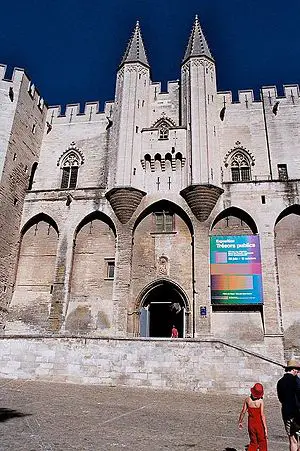
Architecture
Although there is no architecture named French Architecture, Gothic Architecture's old name was French Architecture (or Opus Francigenum). The term "Gothic" appeared later as a stylistic insult and was widely adopted. Northern France is the home of some of the most important Gothic cathedrals and basilicas, the first of these being the Saint Denis Basilica (used as the royal necropolis); other majestic and important French Gothic cathedrals are Notre-Dame de Chartres and Notre-Dame d'Amiens. The kings were crowned in another important Gothic church: Notre-Dame de Reims. Aside from churches, Gothic Architecture had been used for many religious palaces, the most important one being the Palais des Papes in Avignon.
During the Middle Ages, fortified castles were built by feudal nobles to mark their power. When King Philip II took Rouen from King John, for example, he demolished the ducal castle to build a bigger one. Fortified cities were also common, unfortunately most French castles did not survive. This is why Richard Lionheart's castle -Château-Gaillard- was demolished as well as the Château de Lusignan. Some important French castles that survived are Chinon Castle, Château d'Angers, the massive Château de Vincennes and the so called Cathar castles.
Romanesque architecture which used Mooresque architecture prevailed before the rise of the Gothic style. Romanesque churches in France include the Saint Sernin Basilica in Toulouse and the remains of the Cluniac Abbey (largely destroyed during the Revolution and the Napoleonic Wars).
The end of the Hundred Years' War marked the French Renaissance. Several artists from Italy and Spain were invited to the French court, and numerous Italian-inspired residential palaces were built, mainly in the Loire Valley, including the Château de Chambord, the Château de Chenonceau, or the Château d'Amboise. Following the renaissance and the end of the Middle Ages, Baroque Architecture replaced the gothic one. However, in France, baroque architecture found a greater success in the secular domain than in the religious one. In the secular domain the Palace of Versailles has many baroque features. Jules Hardouin Mansart can be said to be the most influential French architect of the baroque style, with his very famous baroque dome of Les Invalides. Some of the most impressive provincial baroque architecture is found in places that were not yet French such as the Place Stanislas in Nancy.
After the French revolution the Republicans favoured Neoclassicism although neoclassicism was introduced in France prior to the revolution with such building as the Parisian Pantheon or the Capitole de Toulouse. Built during the French Empire the Arc de Triomphe and Sainte Marie-Madeleine represent this trend the best.
Under Napoleon III a new wave of urbanism and architecture was given birth. If some very extravagant buildings such as the neo-baroque Palais Garnier were built, the urban planing of the time was very organised and rigorous. For example Baron Haussmann rebuilt Paris. These times also saw a strong Gothic-Revival trend across Europe, in France the associated architect was Eugène Viollet-le-Duc. In the late nineteenth century Gustave Eiffel designed many bridges (like the Garabit viaduct) and remains one of the most influential bridge designer of his time, although he is best remembered for the Eiffel Tower.
In the twentieth century the Swiss Architect Le Corbusier designed several buildings in France. More recently French architects have combined both modern and old architectural styles. The Louvre Pyramid is a good example of modern architecture added to an older building. Certainly the most difficult buildings to integrate within French cities are skyscrapers, as they are visible from afar. France's largest financial district is La Defense, where a significant number of skyscrapers are located. Other massive buildings that are a challenge to integrate into their environment are large bridges; a good example of the way this has been done is the Millau Viaduct. Some famous modern French architects include Jean Nouvel or Paul Andreu.
Art
The first paintings of France are those that are from prehistoric times, painted in the caves of Lascaux well over 10,000 years ago. The arts flourished already 1,200 years ago, at the time of Charlemagne, as can be seen in many hand made and hand illustrated books of that time.
Classic painters of the 17th century in France are Nicolas Poussin and Claude Lorrain. During the 18th century the Rococo style emerged as a frivolous continuation of the Baroque style. The most famous painters of the era were Antoine Watteau, François Boucher and Jean-Honoré Fragonard. At the end of the century, Jacques-Louis David was the most influential painter of the Neoclassicism.
Géricault and Delacroix were the most important painters of the Romanticism. Afterwards, the painters were more realistic, describing nature (Barbizon school). The realistic movement was led by Courbet and Honoré Daumier. Impressionism was developed in France by artists such as Claude Monet, Edgar Degas, Pierre-Auguste Renoir and Camille Pissarro. At the turn of the century, France had become more than ever the center of innovative art. The Spaniard Pablo Picasso came to France, like many other foreign artists, to deploy his talents there for decades to come. Toulouse-Lautrec, Gauguin and Cézanne were painting then. Cubism is an avant-garde movement born in Paris at the beginning of the 20th century.
The Louvre in Paris is one of the most famous and the largest art museums in the world, created by the new revolutionary regime in 1793 in the former royal palace. It holds a vast amount of art of French and other artists, e.g. the Mona Lisa, by Leonardo da Vinci, and classical Greek Venus de Milo and ancient works of culture and art from Egypt and the Middle East.
Cinema
Auguste and Louis Lumière invented the cinématographe and their screening of L'Arrivée d'un train en gare de la Ciotat in Paris in 1895] is marked by many historians as the official birth of cinematography. During the next few years, filmmakers all over the world started experimenting with this new medium, and France's Georges Méliès was influential. He invented many of the techniques now common in the cinematic language, and made the first ever science fiction film A Trip to the Moon (Le Voyage dans la Lune, 1902). Alice Guy Blaché was one of the first pioneers in cinema. She made her first film in 1896, La Fée aux Choux, and was head of production at Gaumont 1897-1906, where she made in total about 400 films. Her career continued in the United States.
During the period between World War I and World War II, Jacques Feyder became one of the founders of poetic realism in French cinema. He was also a dominating character within French Impressionist Cinema. The French film industry suffered from a lack of investment after the First World War, creating an opportunity for the US film industry to enter the European cinema market with their own films, which could be sold cheaper than the European productions. A quota system was introduced to protect French cinema.
In 1937 Jean Renoir, the son of famous painter Pierre-Auguste Renoir, directed what many see as his first masterpiece, La Grande Illusion (The Grand Illusion). In 1939 Renoir directed La Règle du Jeu (The Rules of the Game). Several movie critics have cited this film as one of the greatest of all-time.
Modern film theory was born in the critical magazine Cahiers du cinéma, founded by André Bazin, in which critics and lovers of film would discuss film and why it worked. Cahiers critics such as Jean-Luc Godard, François Truffaut, and Claude Chabrol, went on to make films themselves, creating what was to become known as the French New Wave. Some of the first movies of this new genre was Godard's Breathless (À bout de souffle, 1960), starring Jean-Paul Belmondo and - the leading movie - Truffaut's The 400 Blows (Les Quatre Cent Coups, 1959) starring Jean-Pierre Léaud.
Cuisine
French cuisine is considered to be one of the world's most refined styles of cooking that evolved over the centuries. The Middle Ages brought lavish banquets to the upper class with ornate, heavily seasoned food prepared by chefs such as Guillaume Tirel. The era of the French Revolution, however, saw a move toward fewer spices and more liberal use of herbs and refined techniques, beginning with François Pierre La Varenne and further developing with the famous chef of Napoleon Bonaparte and other dignitaries, Marie-Antoine Carême.
French cuisine was codified in the twentieth century by Georges Auguste Escoffier to become the modern version of haute cuisine. Escoffier's major work, however, left out much of the regional character to be found in the provinces of France. Gastro-tourism and the Guide Michelin helped to bring people to the countryside during the twentieth century and beyond, to sample this rich bourgeois and peasant cuisine of France. Basque cuisine has also been a great influence over the cuisine in the southwest of France.
The three main meals are le petit déjeuner (break-fast), a light meal of bread, cereal, yogurt, and coffee or hot chocolate, le déjeuner (lunch), and le dîner (dinner) involve a first course (l'entree) and a main dish, followed by cheese and/or dessert. A typical family meal starts with a soup, followed by vegetables and a meat dish and then a salad, cheese, and dessert. Wine is served at meals — children start to drink wine at family dinners in their early teens, often diluted with water.
Literature
French literature tracks its origins back to the Middle Ages. French was not yet a uniform language but was divided into several dialects (mainly: northern oïl, southern oc dialects). Each writer used his own spelling and grammar. Several French mediaeval texts are not signed- such is the case with Tristan and Iseult, or with Lancelot and the Holy Grail, among many others. A significant part of mediaeval French poetry and literature was inspired by the Matter of France, such as the The Song of Roland and the various Chansons de geste. The "Roman de Renart" was written in 1175 by Perrout de Saint Cloude, and told the story of the medieval character Reynard ('the Fox'); it is also a popular example of early French story-telling.
In spite of the anonymous character of many French writings of the Middle-Ages, some medieval writers became quite famous: Chrétien de Troyes, for instance. Occitan culture was also quite influent in the Middle Ages. An early example of a vernacular poet writing in Occitan was Duke William IX of Aquitaine.
About the history of the French language, one of the most important writer is unquestionably François Rabelais. Modern French took a great deal from his style. His most famous work is quite probably Gargantua and Pantagruel. Later on, Jean de La Fontaine wrote his famous "Fables", a collection of short stories, written in verse, and usually ending with a "moral teaching".
But it is most certainly in the eighteenth and nineteenth centuries which French literature and poetry reach its highest point. The eighteenth century saw the writings of such huge writers, essayists and moralists as Voltaire, Denis Diderot and Jean-Jacques Rousseau. As concerns French children's literature in those times, Charles Perrault was probably the most prolific writer, with stories such as: "Puss in Boots", "Cinderella", "Sleeping Beauty" and "Bluebeard".
The nineteenth century saw the birth of many French novels of world renown; Victor Hugo, Alexandre Dumas and Jules Verne are probably among the most famous among these writers, both in and outside of France, with such highly popular novels such as The Three Musketeers, The Count of Monte-Cristo, Twenty Thousand Leagues Under the Sea, or The Hunchback of Notre-Dame. Other nineteenth century fiction writers include Emile Zola, Guy de Maupassant, Théophile Gautier and Stendhal.
Symbolist poetry of the turn of the nineteenth century also proved to be a strong movement in French poetry, with artists such as Charles Baudelaire, Paul Verlaine and Stéphane Mallarmé.
Now become famous outside of France, as well (whereas they used to be mostly known inside of France) are Louis-Ferdinand Céline and Albert Camus. One of the most well-known twentieth century writers is Antoine de St.-Exupéry, whose "Little Prince" has been translated and become a bestseller in a great many countries, remaining popular both with children and adults.
Nowadays, the Prix Goncourt (first given in 1903) rewards "the best and most imaginative prose work of the year". It has quite probably become France's best-known contemporary literary award.
French comic books
French comic books and Francophone Belgian ones are often discussed together. These two countries share a long lasting tradition in comics and comic books. In French they are called bandes dessinées, or more simply BD. It is important to note the French term does not indicate the subject matters. In common English usage the term comics is often associated to what is fun, or funnies while the French language comics are often referred as the le neuvième art (the ninth art). In the USA several French comics would be seen as Graphic novels rather than simply comics. The famous irreductible Gaulois Asterix is the character of the most famous French comics outside France itself, although destined to children at first the BD includes many subtilities and word games that require some culture to be understood. The Black Moon Chronicles were also quite important and inspired a generation of Francophone role-players. Olivier Ledroit who drew albums of the Black Moon Chronicles designed characters and backgrounds for the Heroes of Might and Magic V video game. A new artistic movement called La Nouvelle Manga is trying to merge the Franco-Belgian style with the Japanese one, as mangas are very popular in France and France had an early manga culture.
Music
French music history dates back to organum, an early form of polyphonic singing, in the tenth century. Troubadour songs of chivalry and courtly love were composed in the Occitan language between the tenth and thirteenth centuries, and the Trouvère poet-composers flourished in Northern France during this period. By the end of the twelfth century, a form of song called the motet arose, accompanied by traveling musicians called jongleurs. In the fourteenth century, France produced two notable styles of music, Ars Nova and Ars Subtilior. During the Renaissance, Burgundy became a major center for musical development. This was followed by the rise of chansons and the Burgundian School.
France has a wide variety of indigenous folk music. In the West of France, traditions of ballad-singing, dance-songs and fiddle-playing have survived. Folk dances specific to the West of France include the courante, or maraichine, and the bal saintongeais. Circle- or chain-dances accompanied by caller-and-response singing have been noted. Central France is the home to the French bagpipe tradition, as well as the iconic hurdy gurdy and the dance bourrée. The hurdy gurdy, or vielle-à-roue, is essentially a mechanical violin, with keys or buttons instead of a finger board.
The main form of Basque folk music is called trikitixa, which is based on the accordion and includes popular performers like Benat Achiary and Oldarra. Corsican polyphonic singing is unique. Sung by male trios, it is strongly harmonic and occasionally dissonant. Works can be either spiritual or secular. Corsican musical instruments include the bagpipe (caramusa), 16-stringed lute (cetera), mandolin, fife (pifana) and the diatonic accordion (urganettu). The most popular form of the distinctly CelticBreton folk is the bagad pipe band, which features native instruments like biniou and bombarde alongside drums and, in more modern groups, biniou braz pipes.
The first French opera may be Akébar roi du Mogol, first performed in Carpentras in 1646. It was followed by the team of Pierre Perrin and Cambert, whose Pastoral in Music, performed in Issy, was a success, and the pair moved to Paris to produce Pomone (1671) and Les Peines et les Plaisirs de l'Amour (1672).
One of the major French composers of the early Romantic era, was Hector Berlioz. In the late nineteenth century, pioneers like Georges Bizet, Jules Massenet, Gabriel Fauré, Maurice Ravel and Claude Debussy revitalized French music,and influenced composers like Béla Bartók and Igor Stravinsky.
At the end of World War ll, French musicians were becoming experimental and diverse. Popular musicians from the era included romantics like Édith Piaf, politicized singers like Leo Ferre, morbid sex symbols like Juliette Greco, elegant stars like Charles Aznavour and experimental, often humorous, performers like Georges Brassens and the Belgian Jacques Brel.
The 1950s rock and roll era produced stars like Johnny Hallyday, Richard Anthony, and Claude François, the popular yé-yé girls like Sylvie Vartan and some various music genre like Dalida. France produced progressive rock in the 1970s, while in 1980s, French rock spawned a myriad of styles — pub rock (Telephone), psychobilly (La Muerte), pop punk (Les Thugs), synth pop and punk rock (Bérurier Noir, Bijou). Punk rock rose in the 1970s and continued into the next decade, perhaps best represented by Oberkampf and Metal Urbain.
By 1983, hip hop music had spread from New York City to much of the world. Paname City Rappin (1984, by Dee Nasty) was the first album released, and the first major stars were Suprême NTM, IAM and MC Solaar, whose 1991 Qui Sème le Vent Récolte le Tempo, was a hit.
France has long had a large Algerian minority, who brought their own music to France, most especially raï. Originating in the lower-class slums of the city of Oran, raï shot to the top of the French charts in 1992 with the release of Khaled's self-titled album Khaled. Later performers added influences from funk, hip hop, rock and other styles, creating most notably a pop genre called lover's raï.
Philosophy
French philosophy has been extremely diverse and influential. Michel Eyquem de Montaigne (1533 - 1592) is noted for his anti-dogmatic stances which made him the father of the anti-conformist French spirit. He was the first person to use the word essays, and his writings came to be highly influential upon Shakespeare, Rousseau and Nietzsche. His radical scepticism, summed up in the phrase Que sais-je?, served as one of the catalysts for René Descartes' work. René Descartes (1596 - 1650) changed the primary object of philosophical thought from ontology to epistemology. Voltaire (1694-1778) came to embody the Enlightenment with his criticisms of Church dogma and French institutions, his defence of civil liberties and his support of social reform.
Jean-Jacques Rousseau (1712-1778) distinguished himself from the progressive scientism of the Enlightenment with his proclamation that art and science are corruptors of human morality. Denis Diderot (1713-1784) was a key collaborator in the creation of the Encyclopédia, a systematic collection of all the information of the arts and sciences that caused great controversy.
Henri Bergson (1859-1941) was somewhat of a celebrity. All of Henri Bergson’s works were concerned with his theory of real time as it’s experienced by consciousness. Jean-Paul Sartre (1905-1980) defined his existentialism as drawing all the conclusions from a consistent line of atheism. His major thesis is that existence precedes essence. Albert Camus (1913-1960) rejected being labelled an existentialist, preferring to be called an absurdist. Simone de Beauvoir (1908-1986) was an existential feminist. Beauvoir believed that through surrounding women in a false aura of mystery, man had turned her into the other, which is always the underclass.
Theatre
For the first decades of the sixteenth century, public theater remained largely tied to its long medieval heritage of mystery plays, morality plays, farces, and soties, although the miracle play was no longer in vogue. By 1503, original language versions of Sophocles, Seneca, Euripides, Aristophanes, Terence and Plautus were all available in Europe and the next 40 years would see humanists and poets both translating these classics and adapting them.
France's greatest dramatists emerged during the rreign of Louis XIV. Pierre Corneille (1606-1684), whose tragic masterpiece The Cid (1637), remains unequaled in the grandeur of its conception, wrote over 30 plays, following the Aristotelian unities of time, place, and action. Jean Racine (1639-1699) had simpler style and more realistic characters and plot structures. In the comic arena Molière (1622-1673), ranging from the farcical to the sharpest explorations of social, psychological, and metaphysical questions, created a body of plays that seem as fresh and pointed today as they were when first produced. His masterpieces were Tartuffe (1664) and The Misanthrope (1666).
French theater in the nineteenth century was at first dominated by the romantic dramas of Victor Hugo (1802-1885), whose Hernani (1830) liberated playwrights from the confining traditions of the past, and by those of Alexandre Dumas the elder (1802-1870). Alexandre Dumas the younger, who also defended social theses.
Edmond Rostand wrote the flamboyant Cyrano de Bergerac (1897), Jean Giraudoux wrote poetical plays, especially the astringentMadwoman of Chaillot (1945), while Jean Anouilh (1910-1987) is known for Eurydice (1941) and Antigone (1942).
Eugène Ionesco (1909-1994) wrote The Bald Soprano (1950) bringing a new drama called the theater of the absurd, a genre that includes yhe plays of Jean Genet (1910-1986), such as The Balcony (1956) and The Blacks (1958).
Sport
Popular sports include football (soccer), both codes of rugby football and in certain regions basketball and handball. France has hosted the 1938 and 1998 FIFA World Cups, and hosted the 2007 Rugby Union World Cup. Stade de France in Paris is the largest stadium in France and was the venue for the 1998 FIFA World Cup final, and hosted the 2007 Rugby World Cup final in October 2007. France also hosts the annual Tour de France, the most famous road bicycle race in the world. France is also famous for its 24 Hours of Le Mans sports car endurance race held in the Sarthe department. Several major tennis tournaments take place in France, including the Paris Masters and the French Open, one of the four Grand Slam tournaments.
France is the country of creation of the Modern Olympic Games, due to a French aristocrat, Baron Pierre de Coubertin, in the end of the nineteenth century. After Athens in reference to the Greek origin of the ancient Olympic Games, Paris hosted the second Games in 1900. Paris was also the first home of the IOC, before moving to Lausanne for more neutrality. During the Modern era, France has hosted the Olympic Games fives times: two Summer Games (1900 and 1924, both in Paris) and three Winter Games (1924 in Chamonix -the first edition-, 1968 in Grenoble and 1992 in Albertville).
Both the national football team and the national rugby union team are nicknamed "Les Bleus" in reference to the team's shirt color as well as the national French tricolor flag. The football team is regarded as one of the most skillful teams in the world with one FIFA World Cup victory in 1998, one FIFA World Cup second place in 2006, and two European Championships in 1984 and 2000. The top national club competition is the Ligue 1. Rugby is very popular, particularly so in the southwest of France and Paris. The national team have competed at every Rugby World Cup, and take part in the annual Six Nations Championship. The French rugby team has never won a World Cup (despite having reached the semi-finals on all but one occasion, and playing in two finals), yet it has won sixteen Six Nations Championship, including eight grand slams. They are considered one of the top teams in the world. The top national club competition is the Top 14.
International rankings
- Total GDP, 2005: 6th (out of 180) (World Bank data)
- Total value of foreign trade (imports and exports), 2002: 4th (out of 185)
- Reporters Without Borders world-wide press freedom index 2005: Rank 30 out of 167 countries
- Transparency International Corruption Perceptions Index 2006 - 18th of 163 countries
ReferencesISBN links support NWE through referral fees
External links
- France World fact Book 2007, accessed November 7, 2007.
- Culture of France Countries and Their Cultures Cr-Ge, accessed November 8, 2007.
- Official site of the French Embassy in the United Kingdom
- Official site of the French public service - Contains many links to various administrations and institutions
- France Encyclopædia Britannica Online
- France World Factbook 2007, accessed November 7, 2007.
- Phone numbers from France Télécom]
- Travel guide to France from Wikitravel
Culture
- Cocorico! French culture
- Contemporary French Civilization, journal, University of Illinois.
Credits
New World Encyclopedia writers and editors rewrote and completed the Wikipedia article in accordance with New World Encyclopedia standards. This article abides by terms of the Creative Commons CC-by-sa 3.0 License (CC-by-sa), which may be used and disseminated with proper attribution. Credit is due under the terms of this license that can reference both the New World Encyclopedia contributors and the selfless volunteer contributors of the Wikimedia Foundation. To cite this article click here for a list of acceptable citing formats.The history of earlier contributions by wikipedians is accessible to researchers here:
- France history
- Geography_of_France history
- Paris history
- History_of_France history
- Economy_of_France history
- Economic_history_of_France history
- Demography_of_France history
- Education_in_France history
- French_people history
- Religion_in_France history
- French_language history
- Social_class_in_France history
- Culture_of_France history
- French_architecture history
- French_cuisine history
- Music_of_France history
The history of this article since it was imported to New World Encyclopedia:
Note: Some restrictions may apply to use of individual images which are separately licensed.
- ↑ 1.0 1.1 Whole territory of the French Republic, including all the overseas departments and territories, but excluding the French territory of Terre Adélie in Antarctica where sovereignty is suspended since the signing of the Antarctic Treaty in 1959.
- ↑ (French) INSEE, Government of France. Tableau 2 - Répartition de la population totale par groupe d'âges, France métropolitaine. Retrieved 2007-04-01.
- ↑ (French) INSEE, Government of France. Bilan démographique 2006 : un excédent naturel record. Retrieved 2007-04-01.
- ↑ 4.0 4.1 4.2 Metropolitan France only.
- ↑ Whole of the French Republic except the overseas territories in the Pacific Ocean.
- ↑ French overseas territories in the Pacific Ocean only.
- ↑ In addition to .fr, several other Internet TLDs are used in French overseas départements and territories: .re, .mq, .gp, .tf, .nc, .pf, .wf, .pm, .gf and .yt. France also uses .eu, shared with other members of the European Union.
- ↑ Rank by nominal GDP: 6 (2006); Rank by GDP per capita: 17 (2005); Rank by GDP at purchasing power parity per capita: 21 (2005).

